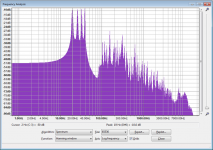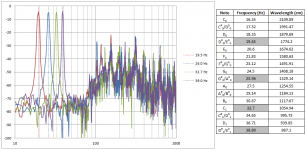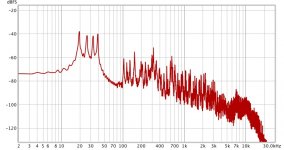On the Enya track “Longships” there is a drum fundamental at 12Hz that is completely lost without a true subwoofer. No, you can’t hear these frequencies, but you can feel them as a “shudder” in the air around you.
Wow! Your post brought up OLD memories of experimenting with MFB and EQ to extend subwoofer response flat to below 10Hz. This song was one I tested where it made no audible difference if the sub had output capability below 30Hz or not. It really confused me since that “shudder” sure made me feel it did. I eventually borrowed an HP spectrum analyzer to measure what frequency content was actually in the song, and it showed nothing below 30hz.
Of course that was 30 years ago. Now we are spoiled with the capabilities of free audio software. The results are the same though. Attached are *.zip files containing *.mp3 audio clips of the relevant section. One is untouched, another has a 28Hz HP filter applied, the third has a 28Hz HP and 50Hz LP filter applied. Pics of the spectrums for each file are also attached.
As you can see, nothing going on below 30Hz. The 28Hz HP version sounds exactly like the untouched version. So, what is causing the “shuddering”? It is beating between the closely spaced 32Hz, 37Hz, and 44Hz tones. The HP28_LP50 version of the clip lets you more easily hear just the bass tones and the beating. If you are unfamiliar with beat tones, you might check these links (both have examples you can listen to)
Beats. From Physclips
Beats
I have read that sometimes low notes on pipe organs are actually “faked” with beats if full length pipes are not possible due to size constraints.
Just for grins, I generated a *.wav file containing the 3 individual tones at the same amplitude shown in the spectrum analysis. First each individual tone is played separately, then the 32Hz and 44Hz together, and lastly all 3 together.
Attachments
-
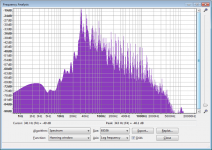 Longship_clip.png150.9 KB · Views: 390
Longship_clip.png150.9 KB · Views: 390 -
Beat_test_3tones.zip651.9 KB · Views: 35
-
Enya - The Longships_clip_HP28_LP50.zip320 KB · Views: 40
-
Enya - The Longships_clip_HP28.zip587.7 KB · Views: 42
-
Enya - The Longships_clip.zip586.8 KB · Views: 36
-
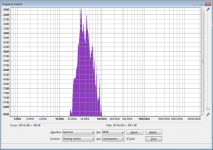 Longship_clip_HP28_LP50.png116.6 KB · Views: 396
Longship_clip_HP28_LP50.png116.6 KB · Views: 396 -
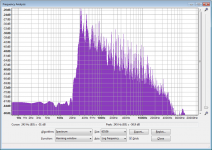 Longship_clip_HP28.png148.4 KB · Views: 404
Longship_clip_HP28.png148.4 KB · Views: 404
Last edited:
Can't believe I forgot, if you want to listen to an Enya song that has high level bass content below 30Hz,
you can download a “Rebassed” version of “Only Time” here: (link is in comments) YouTube
A clip of the song showcasing the descending bass tones(39, 33, 26, 19Hz) is attached in *.zip file.
Pics of spectrum analysis also attached. Silly loud bass, but kinda fun in small doses.
you can download a “Rebassed” version of “Only Time” here: (link is in comments) YouTube
A clip of the song showcasing the descending bass tones(39, 33, 26, 19Hz) is attached in *.zip file.
Pics of spectrum analysis also attached. Silly loud bass, but kinda fun in small doses.
Attachments
Screwball music. Easy to listen only if your system isn't able to put out flat volume below 30 Hz. The house shakes with my 17-foot 12 Hz pipe. Who is the intended audience? Interesting to see drop south of 100 Hz. Cooked, all cooked... but is it nice?
And here's a replication of Bolserst's zip. On the money which only proves my gear is OK.
Gear: 2010 MacBook Air, iTunes player, out the headphone jack to DAC, in USB from my $4 early Sound Blaster DAC from the Salvation Army store. Elsewhere I have posted how satisfactory is the built-in laptop mic too.
Thanks, Bolserst.
Sure wish I could figure out how to do an RTA with REW without going in and out of the Mac headphone jack, excellent as that is. Anybody?
B.
17-foot labyrinth
You can use your laptop mic - diyAudio
And here's a replication of Bolserst's zip. On the money which only proves my gear is OK.
Gear: 2010 MacBook Air, iTunes player, out the headphone jack to DAC, in USB from my $4 early Sound Blaster DAC from the Salvation Army store. Elsewhere I have posted how satisfactory is the built-in laptop mic too.
Thanks, Bolserst.
Sure wish I could figure out how to do an RTA with REW without going in and out of the Mac headphone jack, excellent as that is. Anybody?
B.
17-foot labyrinth
You can use your laptop mic - diyAudio
Attachments
Last edited:
Sure wish I could figure out how to do an RTA with REW without going in and out of the Mac headphone jack, excellent as that is. Anybody?
B.
Yes, excellence is over because the headphone jacks (I think without exception, Mac included) are connected with a resistance to ground (high impedance), to minimize the effects so common - and devastating for the output IC - as it is a short in the 3.5 mm plugs.
I have a Sennheisser microphone for vocalists, I gave it to one of my children and never used it. Would it be appropriate to use with REW?
Simple curiosity, I do not intend to dabble for the moment in the subject measurement of the room ....
No, a flat response omni condenser mic would be appropriate for a measurement mic.I have a Sennheisser microphone for vocalists, I gave it to one of my children and never used it. Would it be appropriate to use with REW?
Most vocal mics have a cardiod (heart shaped) pattern, and a frequency response designed for the vocal range. Unfortunately, a side effect of the cardioid pattern also results in the "proximity effect", the LF output will be much lower at distance than at the "normal" close vocal distance.
Any mic you use including the mic in your laptop is better than crying in the dark.No, a flat response omni condenser mic would be appropriate for a measurement mic.
Most vocal mics have a cardiod (heart shaped) pattern, and a frequency response designed for the vocal range.....
Even what a perfect mic does is only hint at how you are hearing things in a live room with two ears and a brain and a loudness contour and final choices depend on hearing.
Even a terrible mic can be 100% useful for A/B comparisons, like when you are tuning your EQ step by step.
B.
with two ears and a brain and a loudness contour and final choices depend on hearing.
B.
Is this.
The lobe seems quite broad, and the answer fairly flat.
No hope? .
But I also think that the impedance and voltage will not be adequate to enter the sound board of my desktop.
I have not seen the specs yet, I just took a look at "bird flight"
Manual de instrucciones de Sennheiser Evolution E 815-S - ManualsBase.com – Soluciona tus problemas
The lobe seems quite broad, and the answer fairly flat.
No hope? .
But I also think that the impedance and voltage will not be adequate to enter the sound board of my desktop.
I have not seen the specs yet, I just took a look at "bird flight"
Manual de instrucciones de Sennheiser Evolution E 815-S - ManualsBase.com – Soluciona tus problemas
As mentioned, this is a “Rebassed” version of the song.Screwball music…Who is the intended audience?
The original is much more artistically consistent: YouTube
The intended audience is those who like bass for the sake of bass. It’s actually a rather large and growing segment of audio enthusiasts which started in car audio and has begun to spill over into personal home theaters with single digit frequency capable subwoofers. It may not be something that interests you or think you would find enjoyable, but you might seek out a local mobile audio convention just to experience what many are enthralled with.
A few examples of the Enya song being enjoyed linked below. (hair and clothing fluttering to the bass)
Searching for “rebass” on youtube will bring up many many songs that have been similarly enhanced for bass aficionados.
YouTube
YouTube
Obviously the recording mic is being clipped by the 150dB+ bass output, but you get the idea.
The Enya track is interesting to me because of the uniform loudness of the stepped tones, the fact that they are pure sine tones, and include one just below 20Hz hearing threshold. Basically if you can hear it instead of just feeling it, your woofer is adding distortion to the pure tones. A nice test when comparing MFB subwoofers with non-MFB subwoofers.
On the Enya track “Longships” there is a drum fundamental at 12Hz that is completely lost without a true subwoofer.
The 'drum fundamental' is at 31 Hz.
Ah I see, already noted by bolserst.
Last edited:
Thats for explanation. Actually I've unwillingly auditioned music of that sort many times: while at traffic stop lights. If I were an audiologist, I'd hand them business cards. And friends sometimes kid me with, "de gustibus non disputandum est"* and who can argue with that.... It may not be something that interests you or think you would find enjoyable, but you might seek out a local mobile audio convention just to experience what many are enthralled with.
A few examples of the Enya song being enjoyed linked below. (hair and clothing fluttering to the bass)...
Basically if you can hear it instead of just feeling it, your woofer is adding distortion to the pure tones. A nice test when comparing MFB subwoofers with non-MFB subwoofers.
Back to topic, subs with even relatively small harmonic distortion will produce the "harmonic" structure for re-inserting the fundamental (although I am not sure if this musical nomenclature applies to sine wave "music"). So folks can hear and (possibly) enjoy this music even with subs that don't go low. But they just aren't enjoying the delights of shaking their sternums or floors and loose knick-knacks in the absence of the fundamental that lower-going systems actually do output physically.
As I posted #263 as a paradox, the signal is so loud that you can't play this at home IF your system is really capable of playing it. Now we have the Bolserst paradox, you can't hear it if only "it" is there.
B.
*there is no disputing about taste; perhaps just Roman defensiveness since nobody ever said they had good taste except as engineers
I'm a basshead, and did measure some of the most bass heavy songs, and even modern dubstep or steppers dub get their lowest notes at 32Hz. I do know classical (organ) music that goes lower (16hz for the lowest note), but that is rare.
I tune, as bassaddict, my subs to 30hz or a bit lower. And then i even hear those low organ notes, so for me it's also not needed to go lower.
Most popmusic from before the late 90's never go under 40Hz, so for most listeners 40Hz is good enough, it's only bass freaks who listen to music like dub, dubstep, dnb or similar music that the 30Hz rule is needed. Some modern pop also have heavy bass, but seldom down to 30hz.
btw, a typical dubsoundsystem is build that a stack of 4 scoops (backloaded subhorns) go to 32hz. And those are among the most bassheavy high power speakers i know. Except maybe some of the designs of Tom Danley (who has a 23hz TH i tought). Most PA subs only go to 40Hz.
I tune, as bassaddict, my subs to 30hz or a bit lower. And then i even hear those low organ notes, so for me it's also not needed to go lower.
Most popmusic from before the late 90's never go under 40Hz, so for most listeners 40Hz is good enough, it's only bass freaks who listen to music like dub, dubstep, dnb or similar music that the 30Hz rule is needed. Some modern pop also have heavy bass, but seldom down to 30hz.
btw, a typical dubsoundsystem is build that a stack of 4 scoops (backloaded subhorns) go to 32hz. And those are among the most bassheavy high power speakers i know. Except maybe some of the designs of Tom Danley (who has a 23hz TH i tought). Most PA subs only go to 40Hz.
For testing the subwoofer I used a Heathkit signal generator
A great kit, mine's been truckin'/'bulletproof' since '68.
GM
The contribution is appreciated, it leaves me more calm because I am one of those who refuse to let the ultra low frequencies shake my viscera, eyeballs, and that my testicles come into resonance !
I ve a closed box 18" sub in my HT, actively OPAMP pushed to reach ~18Hz indoors (at the expense of very low efficiency and high power demand down there). The downfire sub is disguised as a living room table and can shake the house. At an upper crossover of ~70Hz, no one is able to locate the sub and evrybody is starting to look for a sub after the first cinema explosion, whili it is right in front of them. It was really struggling when Sully / Jake in Avatar flapped its wings during his first dragon flight (is it a dragon?) were the mountains are floating. What is the base frequency of those wing flaps? Guess it must be somewhere slightly below 20....
Last edited by a moderator:
Main reason why there isn't so many songs with low frequencies is that people have usually so shitty stereo system so they would not hear it, or might even break something.
When I built a sub to go really low, I also had to do some new mixes of some songs, so I would have material which to play
When I built a sub to go really low, I also had to do some new mixes of some songs, so I would have material which to play
Actually, you don't need any stereo system to convey those low frequencies - a beefy mono system will suffice.
That is true, however, I said "people have usually so shitty stereo system"
Most people listen music from a stereophonic sound system.
On music, you can crossover at least as high as 140 Hz and put a sub anywhere in a room, if the slope is steep and the sub clean no localization. But just a bit better if you tweak the time alignment of the speakers.The downfire sub is disguised as a living room table and can shake the house. At an upper crossover of ~70Hz, no one is able to locate the sub and evrybody is starting to look for a sub after the first cinema explosion, whili it is right in front of them
The higher crossover has important advantages in terms of spectrum division, size and demands made of mid-range boxes, amps, etc.
Much debate about mono versus stereo subs. Some folks doubt the sub freq are different in the L and R signals or that the sonic results is any different if you mix to mono-sub as many of us do.
But with the great interest in multiple subs in a room these days, it is clear that mono or stereo signals, having distributed subs is a major benefit in a room.
B.
Last edited:
- Home
- Loudspeakers
- Subwoofers
- 10-25 Hz, is it necessary for HT or Music?
